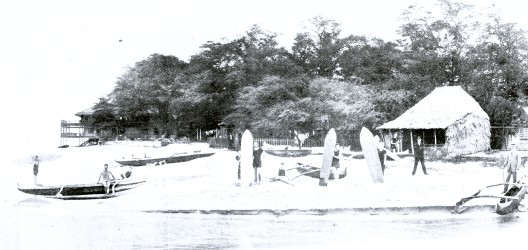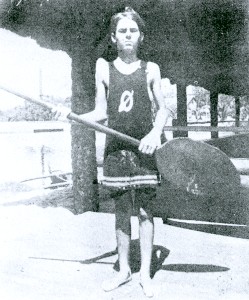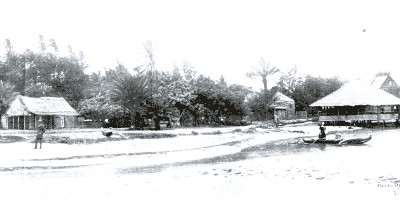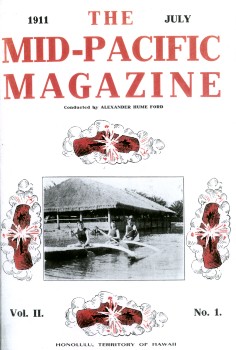 |
surfresearch.com.au
contrell : outrigger canoe club, 1911 |
| home | catalogue | history | references | appendix |
|
 |
|
 |
|
One day a
pair
of malihinis walked along a little stretch of beach at
Waikiki and lamented
the fact that the great hotels and palatial villas of the
rich had so encroached
that practically there was no
public
entrance
to one of the most famous beaches in the world.
The two malihinis looked out on the sea where there were three boys riding on their surf-boards. They asked if it were possible for them to learn the art of standing on the waves on these chips ...
Page 4
(Photograph,
page
4, Grass shack and canoe.)
The
Beginning
of the Outrigger Canoe Club.
... of wood
and
were told that it must be learned in childhood.
One of the
mali-
hinis, a man of forty proved a doubting Thomas and induced
the three youngsters
to show him the way on a board out to the big breakers.
In six weeks
of hard work, eight hours a day, he mastered the art of
standing and riding
on the Hawaiian surf-board.
Furthermore,
he discovered that by being shown the trick of starting and
guiding the
board, a novice could learn how to master the surf in a few
lessons.
He observed,
however, that the beach was practically closed to the small
boy of Hawaii
who could not afford the dally bath house fee.
"Why not
organize
a surf-board club,"' he said to some of the young men and
boys who were
expert surf-board riders, "and secure a place on the beach
on which to
build a clubhouse for those who
wish to
learn
to ride the surf-board ?"
There was a
general
howl of ridicule at the idea of anyone, a malihini least of
all, securing
a bit of property facing Waikiki Beach: but the malihini
didn't see things
just this way.
He found out
that one of the leases for an acre and a haif of ,!?;"rouud
would soon
expire.
This acre
and
a half faced the sea between the two great Waikiki hotels
and was the property
of the Queen Emma Estate.
Here, on
these
grounds, in years gone by, Kamehameha the Great had landed
with their war
canoes the warriors who conquered the Island of Oahu.
Here Queen
Emma
had learned to ride the surf-board.
Here was
built
for her one of the old native grass houses and daily with
her retainer
she would go out as a child to the big surf and come in
standing on her
board.
It was the
most
historic bit of ground in Honolulu and the trustees of the
Estate expressed
a willingness to hand over the property to a club that would
perpetuate
the Hawaiian water sports of which Queen Emma had been so
fond.
Thus it was that for a nominal sum this valuable piece of property was handed over to the malihini, on the condition that he organize a club that would make, it easily possible during the twenty years of the lease for every grown person and voungster in Hawaii to learn to become an adept in the art of guiding Hawaiian outrigger canoes and riding on the surf-board.
The
Outrigger
Canoe Club sprang into existence with a hundred members, and
within a few
months more young people were riding the surf-board and
steering canoe's
than had ever done so since the days of the landing of
Kamehameha's fleet.
To the
astonishment
of the people of Hawaii, it was found that not only could
men of all ages
quickly learn the art of riding the surf-board, but that
even young girls
and women rapidly picked up the accomplishment.
That first
summer
of 1908 the club was in full swing and the requirements ...
Page 5
... of
giving
the grounds an Hawaiian effect were carried out.
There were
two
real Hawaiian grass houses on the Island of Oahu that had
been built with
all the ceremonies attendant on the construction of churc
buildings by
the Hawaiians.
The posts
were
of real ohia wood lashed together with grass ropes, the
walls were lined
with pandamus leaves and the whole thatched with the real
pili grass used
by Hawaiian chiefs on their buildings.
These houses
were secured and moved to the grounds of the Outrigger Club.
Rules were
made
forbidding the harboring of the grounds of any kind of craft
other than
real outrigger canoes.
Once a year
the
native Hawaiian canoeists of the island were invited to make
the Outrigger
grounds their home for several days.
Old Hawaiian
sports of every kind were revived and it was a unique sight
even to the
people of Honolulu to see crews of native women in sailing
and paddling
canoe races.
On the
grounds
from fifty to a hundred Hawaiians lived in native style in
the grass houses,
the women pounding taro into poi, the men baking pigs in
imus, or underground
ovens, and everything proceedings as it did in the days when
Kamehameha
landed on this sport.
The Club
grew
in influence and importance and soon became an institution.
It now
became
necessary to interest the gentler sex.
A grass bath
house was built and a part of the grounds set apart
exclusively for a women's
auxiliary, which soon numbered a hundred members.
The hau
trees
were jacked up on cocoanut posts and trellises and formed
into splendid
outing places for picnics and parties.
In the great
wide lagoon adjoining the Otltrigger grounds was built a big
thatched dancing
pavilion or lanai.
In
everything
the Hawaiian effect was maintained.
Through the courtesy of Frank Clark, of around-the-world cruise fame, magnificent silver trophies for the best boy and girl surf-board riders and canoe ...
Page 6
(Photograph,
page
6, Unclear.)
Illuminated
Surfboard
Riding at Night.
... surfists were offered as an encouragement to those who would become adept in these sports.
It must be
remembered
that the waters of Hawaii remain at about 76 to 78 degrees
of warmth the
year around.
It is in
summer,
however, when the school children have their vacation, that
the waters
of the bay are crowded with canoes and surf-boards and the
grounds with
merrymakers.
On the
grounds
the boys make their own surf-boards and the paddles with
which they guide
the canoes before the great rollers.
Here too
they
fashion the outriggers and lash them to the canoes.
Once more
the
old Hawaiian sports are being revived and bid fair to excel
in every way
anything accomplished in the days of old.
The revival of the old Hawaiian water sports by the Outrigger Club has resulted also in a revival of some of the Hawaiian vernacular.
The
outrigger
of a canoe, to the younger members of the Club especially,
is now divided
into ama and the iaku, the ama being
the parallel
piece of hau tree log, while the two sticks that hold it out
from the canoe
are called iakus.
The canoe
itself
is a waa and the paddle a hoe.
Native names
are invariably given to the canoes and the sentiment is all
in favor of
the royal colors, yellow for the manu or gunwale
and either black
for the body of the canoe or merely the polishing of the
outside of the
koa log from which it is fashioned.
The big
waves
I before which the canoes ride are now called nuinalu,
or big waves,
while the little waves are called piula, or weak.
Gradually,
words
long forgotten by the whites or haoles born in the Islands,
are being revived
for use by the Outrigger enthusiasts.
The revival
of
the surf-board has also had its useful side.
Many lives
have
been saved in the surf through the use of the board.
One member
of
the Outrigger Club has saved as many as eight human lives,
all with the
use of the surf-board.
The
surf-board
can be propelled through the water very much faster than
anyone can swim.
It cuts
through
the incoming waves and quickly reaches anyone in trouble in
the big surf.
The drowning
man is placed on the board and the board shoved toward the
shore.
There is
also
the esthetic side to the Outrigger Canoe Club.
There are
occasions
when scores of canoes are beautifully decorated with
lanterns and a night
water carnival prepared for the delectation of the members
ashore.
Not only
that,
but some of the youngsters have learned the secret of
touching off red
fire on the tips of their boards just as they catch the wave
and their
illuminated figures are seen in outline on the foaming
crest.
The social
entertainments
at the Outrigger Club are among the events of the Honolulu
season, the
Club lanai being the most spacious dancing floor in the
Territory and nearly
every prominent citizen being a supporting member of the
Club.
Perhaps one
Hawaiian
sport that the Club has done least to revive has been that
of native fishing.
Still there are members of the Club who do sometimes go far
out to sea
in their canoes and ...
Page 7
... spear
the
multi-colored fish that swarm in Hawaiian waters.
The usual
method
is to take a glass bottomed box and a twenty-foot spear.
The edge of
the
box is held in the teeth by the swimmer and the spear in the
right hand.
As the fish
is
seen twenty or thirty feet below, the spearman aims his
spear and pierces
the fish.
That is how
it
is done in the daytime.
At night
parties
sometimes wade out on the reef with torches and short
spears.
The fish,
attracted
by the light, dart by between the feet and down comes the
spear.
In fact
there
are all kinds of possibilities, once the Club undertakes to
develop the
sport of native fishing.
Recently a
glass
bottomed boat has been added to the fleet of Hawaiian canoes
owned by the
Club and when the bottom is not broken by a bit of jagged
coral in shallow
waters, it is often used by the curious who like to float
out over the
reefs and see the wonderful growth of coral and the many
colored fish darting
by.
It is
intended
to build just back of the beach on the Outrigger Club
grounds an aquarium
in the sand with coral sides and bottom.
A pipeline
will
lead out to the ocean water and the many colored fish of the
adjacent reefs
will be kept in the aquarium, that the Club members may
learn something
of the different species that may be had near by for the
spearing.
There are
probably
as many canoes in the Club grounds at Waikiki as there are
outside of the
groupds on the entire Island of Oahu.
There are
three
canoes,however, not on the Club grounds, but down at Pearl
Harbor that
the Club envies and which have been promised.
Two of these
canoes are sixty feet in length and it takes fourteen
paddlers at least
to man either one of them.
These are
the
two largest of the old native canoes left on the Islands,
and it is the
intention of the Club to keep them as State canoes for
distinguished visitors
who come to Hawaii.
The Club
will
also make a collection of Polynesian canoes from all around
the Pacific;
in fact, a start has been made in this direction.
The
Outrigger
Club has quickly become an institution that is recognized,
particularly
at carnival time in February.
In the great
Floral Parade on Washington's Birthday there were two noted
entries from
the Outrigger Canoe Club, one a canoe racing down the face
of a curling
wave with two surf-boards at the base of the wave.
The canoe
and
boards were manned by the younger members of the Club.
The other
float
which was placed in the Floral Parade is a model of an old
Hawaiian grass
house with the tapa-beaters at work inside and the poi
pounders at work
without.
This year
the
malihini judges awarded the first prize to the Outrigger
Canoe Club grass
house in the Parade, which indicates that the stranger, at
least, comes
to the Islands to see something of old Hawaii.
Visitors from abroad are welcome at the Outrigger Club, and upon being properly presented and paying monthly dues of one dollar, are welcomed as transient members with all the privileges ...
Page 8
 |
[Photo by Rice and Perkins.] |
... of the Club: in fact, there are probably as many malihini as there are kamaaina members.
No better
idea
of the scope and activity of the Outrigger Club today can be
presented
than the resolutions adopted by the present House Committee
of the Club
and endorsed unanimously by the Board of Directors.
The
following
is the plan of sports and entertainment at the Club for the
present year,
and which will probably be followed for the future.
PROGRAM OF ENTERTAINMENTS FOR 1911.
( 1 ) An entertainnlent to be given in February consisting of native Hawaiian canoe sports, by the men and women of the Kalihi Aquatic Club, they bringing their canoes and poi pounders, baking taro Hawaiian style on the beach and ...
(Photograph,
page
9b, Carrying canoe.)
After the
Ride
in the Surf.
Page 10
...
pounding same
into poi and luauing a pig; the men and women of the club to
engage in
canoe sailing and racing, and surf-boarding.
This
entertainment
to be made an annual event to be known as "Malihini Day" at
the Club, with
a dance to the visitors in the evening.
(2) In the
early
spring a carnival to be given on the grounds of the Club for
the purpose
of raising funds for the definite, fixed purposes herewith
suggested.
That a
committee
first secure a thousand signed subscriptions to the tickets
at $1 each
before same are printed; that as the funds come in the board
of directors
instruct the treasurer to use these funds pro rata on the
improvements
for which the entertainment is given and on general expenses
of the entertainment;
and that this fund be used for no other purposes.
The funds
are
to be expended on a permanent concrete wall, thatching and
rethatching
the lanai and grass houses, filling in, house moving, work
on a hew bathhouse
for the women, a pergola entrance to the grounds, rock
jetties and sand
bagging to preserve the beach, a clubroom adjoining the
large lanai, surfboards
and paddles, and other necessary incidentals in the way of
improving the
grounds prior to the date set for the entertainment.
The
estimated
expenses are as follows:
| Wall
Thatch Filling Housemoving . Boards and paddles Women's bathhouse Pergola Clubroom Rocks and bags for beach Incidental improvements Cost of entertainment Total |
... $375.00
... 100.00 ... 25.00 ... 25.00 ... 25.00 ... 150.00 ... 50.00 ... 100.00 ... 50.00 ... 100.00 ... 200.00 ------------------- $1200.00 |
(3) A joint ball with the other aquatic clubs on Regatta Day evening in the large lanai on the Club grounds.
(4) An Halloween masquerade.
( 5 ) A Christmas dance.
The House and Entertainment Committees also recommend that two or three "get-together" chowders be given, at cost, in the lanai, to which the ladies of the Auxiliary be invited by the men's club.
ATHLETICS
FOR
1911.
( 1) An
annual
"Malihini Day" in February, consisting of Hawaiian sports
and pastimes
on the grounds of the Club and in the surf by native
Hawaiians engaged
for the occasion.
(2) On Kamehameha Day surf-boarding and canoe races, with prizes or decorations to those who invent and carry out new surfing games or contests.
(3) On July 4th, cup races, surfing, swimming and canoeing for the perpetual cups already in possession of the Club.
(4) Canoe race in September for the juniors.
(5) Late in the fall a night carnival of surfing and canoeing- with decorated canoes and fireworks from surf-boards.
(Photograph,
page
10, Illuminated Surfboard Riding at Night, cropped.)
 |
Volume 2 Number 1. Conducted by Alexander Hume Ford, Honolulu, Territory of Hawaii, July,1911. |

| home | catalogue | history | references | appendix |